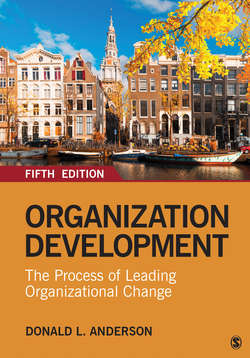Читать книгу Organization Development - Donald L. Anderson - Страница 75
На сайте Литреса книга снята с продажи.
The Value of the Social Construction Approach for OD Practitioners
ОглавлениеThe social construction perspective has gained a following among organization development practitioners because it offers several distinct benefits. First, like systems theory it offers a useful (but different) explanation for human behavior. It explains why, for example, organizational members would be less willing to take risks after witnessing a layoff in another division in which risk taking was common. Perhaps a logic has been developed in which members believe that taking risks means that losing one’s job is likely. As a second example, consider that perhaps an executive decides to terminate a product line that is losing money. Instead of seeing this as a one-dimensional decision based on input from the environment, the social construction perspective helps to articulate the complexities in collecting, interpreting, and sharing the information used to make and communicate the decision. The social construction perspective directs the OD practitioner’s attention to the cultural processes of sensemaking that result in action.
Second, the social construction perspective emphasizes the active role that members take in creating the organization. Members may decide to create a new department, change a structure, adopt new titles, or change a process. While an individual member may not have the choice to change a certain policy, the policy is one developed by organizational members and created for the organization’s benefit. Relationships among supervisors and employees are not confined to rigid role-based interactions, but are multidimensional and can be friendly, cold, formal, sociable, and so on. Relationships between coworkers or departments are more complex than simply sharing orders or instructions between them and can be cooperative or contentious, relaxed or rigid. The social construction perspective illustrates the active choice that we make in creating these systems and relationships. This implies that OD practitioners should create situations in which people can choose a different organization to create, such as new policies, processes, roles, or relationships. Accepting this adaptability gives practitioners and organizational members the freedom to create changes that they desire to see (within boundaries, frequently, that we also agree to respect). While this does not deny the importance of leadership in change or the financial or environmental realities, it places an equal emphasis on everyday conversations that occur in the organizational network among all participants.
Third, the social construction perspective helps OD practitioners to see the importance of communication in creating change (J. D. Ford & Ford, 1995):
Stories, myths, rituals, and language use are not simply reflections of organizational meanings; they are the ongoing dynamics that constitute organizational life. Meanings, then, do not reside in messages, channels, or perceptual filters. Rather, they evolve from interaction processes and the ways that individuals make sense of their talk. (Putnam, 1983, p. 40)
Words and their context are important, and the interpretive processes that we use to make sense of words often go unexplored. Consider a situation in which an organization, under financial pressure and rumors of layoffs, is required by law to send out an annual benefits notice to all employees. The notice states that following an involuntary termination, employees are eligible for continued medical benefits for a length of time following termination. From the perspective of the human resources benefits department, this is an ordinary compliance activity, but from an employee’s perspective, it could be alarming to receive such a notice unexpectedly mailed to one’s home, considering the context. OD practitioners can become attuned to context, language, and interpretation mechanisms and help organizational members become more explicit about their interpretations. They can understand the context for interpretation of any particular message and make better recommendations about how communication will be received. Jeffrey and Laurie Ford (1995) write that communication is not just another part of change, but it is the primary means by which change occurs.
Finally, the social construction perspective stresses that organizational change has as its foundation a change in meaning. Sensemaking logics lie beneath values, beliefs, and attitudes, as well as organizational practices, identities, and processes. Simply changing a practice, a role, a title, or a department name does not always change the underlying interpretive processes that members have adopted. Consequently, the approach assumes that change can best be accomplished when organizational members have the opportunity to work together to define new practices (Weick, 1995).
